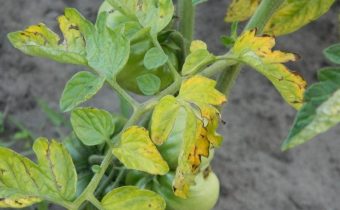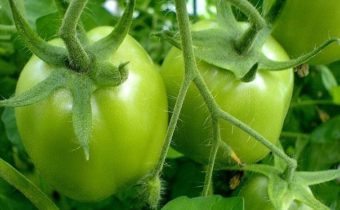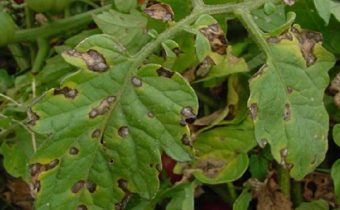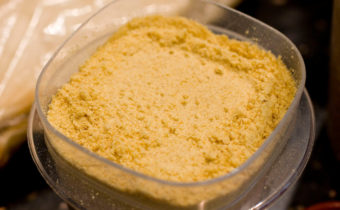Why and what to do if a tomato has small upper leaves and curls
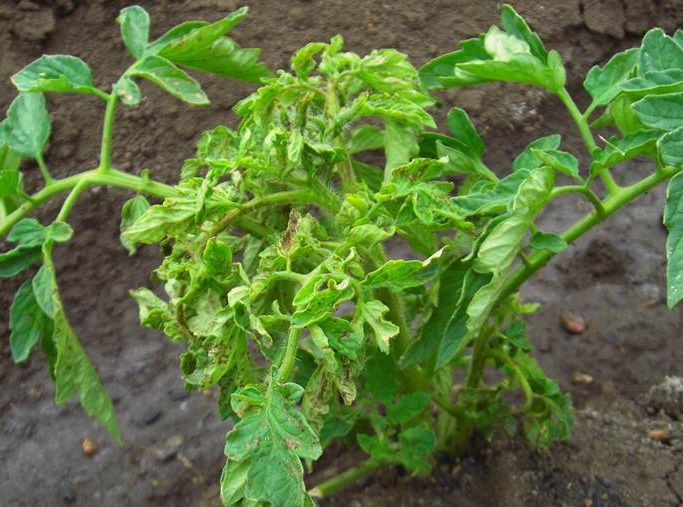
Having seen that leaves curl at tomatoes, it is necessary to find out quickly the cause of the phenomenon. In case of violation of agricultural engineering, it is easier, more difficult to correct the situation, if the changes are caused by infections.
Leaf curling in tomatoes: possible causes
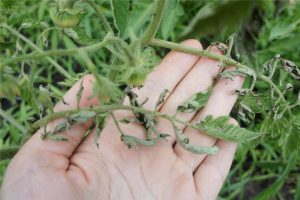
A change in leaf blade in tomatoes occurs under various conditions:
- the emergence of infectious diseases;
- violation of agrotechnical techniques.
Twisting the top, chopping the leaves - a signal to the gardener that tomatoes need treatment or adjustment of care.
Another reason for the appearance of the upper leaves twisted like a “boat” can be a varietal feature.
A number of tomato varieties and hybrids the leaf plates are thin, the edges are heavily cut and because of this they are bent, curled. In the list of such tomatoes:
- Fatima;
- Oxhart (Germany);
- Cherry;
- Honey drop;
- Japanese crab.
The absence of brittleness, stains, abscission of leaves is a sign that the plants are fine and have nothing to worry about. In all other cases, you will have to figure out the cause, take action.
Incorrect agrotechnology
Twisting the upper leaf plates of tomatoes cause:
- violation of irrigation;
- soil nutrient deficiency or excess;
- temperature changes.
It is enough to adjust the mode, care for the plants more carefully and the problem will be solved.
Water deficit
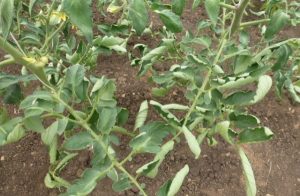 Tomatoes roll the leaves with an insufficient amount of moisture.
Tomatoes roll the leaves with an insufficient amount of moisture.
Culture likes abundant, but rare irrigation, so that moisture penetrates the soil to a sufficient depth, not accumulating only in the upper layers.
With a deficit of moisture, the plant is protected by reducing the area of the leaf plates due to twisting for less evaporation.
What to do:
- gently water the plants, trying not to fall on the leaves, flowers, fruits;
- adjust the irrigation schedule, taking into account the weather conditions and the condition of the tomatoes (1-2 times a week);
- use warm and separated water for irrigation (+ 20ºC… + 22ºC);
- observe the rate of watering, pouring at least a liter of water under the adult plant.
After a long period of drought, water the tomatoes gradually, gently shed the soil.
To preserve moisture in the soil, it is recommended to grind the surface with mowed grass, humus, peat or straw.
Excessive humidity
The leaves “twist” because of the excess moisture in the soil, while the edges are bent not inwards but outwards. The reason is easily identified:
- too wet ground;
- the fragility of the side shoots and stems on plants;
- depressed kind of bushes.
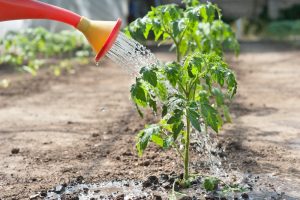 Tomatoes growing on ridges suffer from strong waterlogging during periods of prolonged rains.
Tomatoes growing on ridges suffer from strong waterlogging during periods of prolonged rains.
Greenhouse plants twist the leaves due to heavy irrigation, and because of the high humidity in the shelter.
What to do:
- stop watering plants in the greenhouse for a while;
- for tomatoes growing in the open field to make canopies with a film (arcs, awnings);
- make small ridges on ridges to drain excess water.
The problem does not occur in plants planted in loose, well-structured nutrient soil. Culture does not like heavy soils, so they cultivate them, bringing peat, sand, humus.
To avoid overmoistening the soil, as well as drying out, mulch helps.
Peat, sawdust, hay absorb excess water, prevent its rapid evaporation, contribute to the preservation in the soil of a normal moisture balance.
Improper plant nutrition
By twisting the leaves, changing their color leads to a lack or excess of certain nutrients.
Excess nitrogen
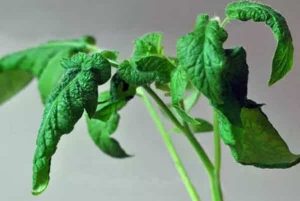 With the prevalence of nitrogen in the dressing tomatoes actively grow the leaves, while the plates on the top of the stem are twisted into a ring.
With the prevalence of nitrogen in the dressing tomatoes actively grow the leaves, while the plates on the top of the stem are twisted into a ring.
The quantity of color, ovaries decreases, the plant "zhiruet".
What to do:
- gently remove 1-2 leaves on a bush;
- shed a bed with tomatoes with water, as nitrogen is quickly washed out of the soil;
- adjust the norms of fertilizing, eliminating nitrogen.
In preparing the ridges before planting tomatoes, only rotted manure, humus, and compost are introduced.
Potassium deficiency
In case of potassium deficiency, brown spots first appear on the leaf blades and then a twisted border. The plant is stunted, slowing the formation of ovaries.
What to do:
- pour over tomatoes with a solution of potassium sulfate (1 gram of fertilizer is diluted in a bucket);
- use watering potassium nitrate (15 grams of fertilizer per bucket of water).
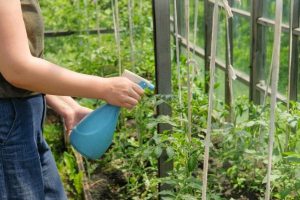 Instead of watering, spray tomatoes with potassium monophosphate (2 grams of fertilizer are required per liter of water), or potassium nitrate (10 grams of the preparation are taken per 1 liter of water).
Instead of watering, spray tomatoes with potassium monophosphate (2 grams of fertilizer are required per liter of water), or potassium nitrate (10 grams of the preparation are taken per 1 liter of water).
Fertilizing with potassium humate gives a good result, especially if tomatoes are growing on alkaline or podzolic soils.
In a bucket of water (10 liters) dilute 3-4 grams of humate, wate at the root.
Phosphorus deficiency
With a lack of phosphorus, the leaves acquire a grayish color, wrap down at the edges, become hard. The veins of the laminae change color from green to purple-purple.
Tomato is a culture sensitive to phosphorus deficiency. With a deficit of the element, the yield is reduced, the taste of the tomatoes deteriorates.
What to do:
- add dry superphosphate to the soil (standard: 10-15 grams per bush);
- spray the bushes with an extract of superphosphate.
 To prepare the composition, first dissolve the granules or powder in hot water (3 liters of liquid –3 tablespoons of fertilizer), leave for a day until the solution turns white. Then process the bushes with a finished hood. Excellent fertilizer - ash infusion, used with a lack of nutrition in tomatoes, phosphorus, potassium. To prepare it, take 2 liters of sifted ash, pour in the same amount of hot water, mix thoroughly. Then add water to a total volume of 10 liters, insist 1-2 days until all components are completely dissolved.
To prepare the composition, first dissolve the granules or powder in hot water (3 liters of liquid –3 tablespoons of fertilizer), leave for a day until the solution turns white. Then process the bushes with a finished hood. Excellent fertilizer - ash infusion, used with a lack of nutrition in tomatoes, phosphorus, potassium. To prepare it, take 2 liters of sifted ash, pour in the same amount of hot water, mix thoroughly. Then add water to a total volume of 10 liters, insist 1-2 days until all components are completely dissolved.
When watering, take a liter of infusion, pour in 9 liters of water, mix and deposit 1-1.5 liters under the root of each tomato bush.
Magnesium deficiency
The appearance on the leaf of a tomato between the veins of light green, and then yellow spots and twisting the edges upwards, towards the middle, is a signal that the plants lack magnesium. With a deficiency of this element whitish spots appear on the fruit.
What to do:
- water the tomatoes with a solution of magnesium sulfate (for 10 liters of warm water, take 30 grams of fertilizer);
- spray bushes with magnesium sulfate (working solution: 15 grams of sulphate for a bucket of warm water).
Processing on leaves gives the effect faster in cool weather, while watering under the root is recommended on hot days.
Heat
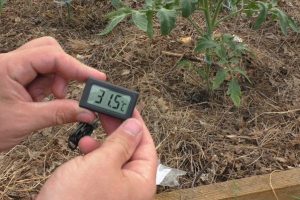 The leaf blades curl from extreme heat, and this happens in greenhouses, on ridges. The reason is easily recognized: during the night, the temperature is normalized, the tomatoes spin sheets.
The leaf blades curl from extreme heat, and this happens in greenhouses, on ridges. The reason is easily recognized: during the night, the temperature is normalized, the tomatoes spin sheets.
What to do:
- for plants in the greenhouse arrange ventilation;
- process tomatoes by leaves with a weak solution of potassium permanganate;
- in the hot days to equip sheds for plants, so that they suffer less from the heat;
- mulch the soil surface (layer - not less than 10 cm).
Do not forget about regular watering, loosening the soil around the plants.
In a greenhouse with tomatoes, the air temperature should not exceed + 30ºC… + 32ºC.
To air the greenhouse after each watering, opening the doors, air vents, arranging drafts.
Incorrect staging
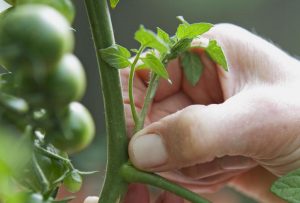 The formation of tomato bushes, the timely removal of lateral shoots (stepchildren) are mandatory methods of agricultural cultivation.
The formation of tomato bushes, the timely removal of lateral shoots (stepchildren) are mandatory methods of agricultural cultivation.
But they should be carried out on time, otherwise there is an imbalance between the root system and the land part of the plant, the plant is under stress.
As a defensive reaction - twisting the leaves of the tomatoes at the top, the lethargy of the stems.
When staving:
- remove shoots 5-6 cm long;
- leave a small, 1-1.5 cm "stump";
- water the plants before removing the stepsons so that the stems become more fragile;
- procedure in the morning, it minimizes the occurrence of infections.
From one bush to remove no more than 2-3 stepsons, 1-2 leaves. When more shoots are removed, the plant not only twists the leaves, but also resets the color, the ovaries.
If this situation has happened, the way out is simple: ensuring regular watering, loosening or mulching, mandatory ventilation for tomatoes in the shelter.
Diseases and pests
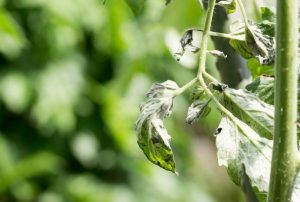 Great damage to the plants cause all kinds of infections and pests. Pathology of leaf blades is caused by insects:
Great damage to the plants cause all kinds of infections and pests. Pathology of leaf blades is caused by insects:
- aphid;
- whitefly;
- spider mite
Twisting the leaves is also one of the signs of disease, including:
- brown spot;
- tobacco mosaic;
- Fusarium;
- bacterial cancer.
Treatment and pest control are not always successful, so prevention is the main measure.
Leaf pests
On tomatoes there are various types of aphids (black, white, potato), while there is a pest at any stage of the growing season. On the underside of the leaf, entire insect populations are found.
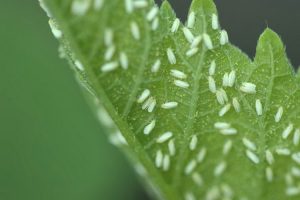 The whitefly butterfly is dangerous, the larvae of which, like aphids, feed on the sap of tomato leaves and stems. Adults kill leaves, and literally in 4-5 days only a stalk and side shoots remain from a tomato bush.
The whitefly butterfly is dangerous, the larvae of which, like aphids, feed on the sap of tomato leaves and stems. Adults kill leaves, and literally in 4-5 days only a stalk and side shoots remain from a tomato bush.
A spider mite lives on the back of the leaves, also sucking the plant sap. It is easy to find it: the leaves fade, curl, there is a barely noticeable cobweb.
For pest control use:
- drugs Fitoverm, Akarin, Borneo - from tick; Aktellik, Konfidor, Pegas - from the whitefly; Phyto farm, Biotlin, Akarin, Karbofos - from aphids;
- infusions of herbs: onion, garlic, tobacco, dandelion;
- ash solution (watering, spraying);
- dusting ashes of plants, soil;
- the use of phytophages - insects that eat pests.
As a preventive measure:
- acquire healthy seedlings;
- remove plant residues from the beds and from the greenhouse;
- observe modes of watering, airing;
- after harvesting, disinfect shelters with potassium permanganate, copper sulfate solution;
- freeze the soil in the greenhouse;
- before planting tomatoes cultivate the ground with a solution of potassium permanganate for disinfection;
- to attract beneficial insects to the site: ladybirds, hoverlings, destroying pests;
- planted in the vicinity of a tomato plant with a strong aroma: marigold, chamomile, dill, garlic.
Do not forget about crop rotation, crop alternation at the site.
Infectious diseases
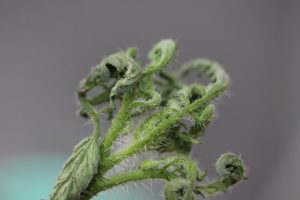 It is difficult to treat infections that cause the twist of tomato leaves.
It is difficult to treat infections that cause the twist of tomato leaves.
When the tobacco mosaic virus on the surface of the leaf plates appear yellowish spots, the border twists, dries. The infection quickly passes to the neighboring plants, damaging the planting of tomatoes. Remove infected plants, burn them. Shrubs that grow nearby, process the drug Aviksil, infusion of whey. Soil shed solution Farmayoda.
Leaves curl and wilt observed in bacteriosis, and the symptoms often appear overnight. Bacteriosis is not treatable. Immediately remove the plant from the bed or from the greenhouse, check the adjacent tomatoes.
On plants entering the fruiting stage, twisting and wilting causes the disease Fusarium. What distinguishes the disease from the lack of nutrients is that it starts from the bottom and goes up, the wilting of the top and the twisting of the leaves occurs later, the leaves on the side shoots fade and turn yellow at the bottom. For the treatment of drugs used Fundazol, Vectra, but they give little effect. Remove, burn, replace the infected plants or disinfect the soil (Trichodermin solutions, Planriz).
Disease prevention:
- purchase of quality seed material;
- disinfection of seeds before sowing (potassium permanganate);
- decontamination of inventory, greenhouse structures;
- removal of vegetable garbage from the ridges and from greenhouses during the growing season, after harvesting;
- compliance with irrigation, fertilizing;
- selection of varieties and hybrids resistant to infections;
- compliance with the planting scheme, the exclusion of tomato thickening.
Diseases can be avoided with proper farming practices and caring for plants.
When twisting the leaves of tomatoes there is no single recipe for help. The main thing is to find out the reason, and then carry out the necessary activities.


